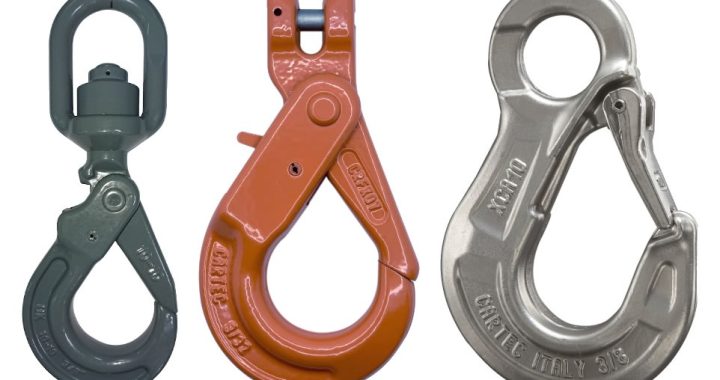Know Your Grade: Choosing the Right Chains and Hooks for the Job
When it comes to rigging, understanding grades of chains and hooks is just as critical as selecting the right size or style. Whether you’re securing loads or lifting them overhead, using the correct grade of chains and hooks isn’t just a recommendation — it’s a safety requirement!
Chain hooks generally come in two styles:
- Clevis Hooks, which attach directly to a chain.
- Eye Hooks, which connect via a connecting link.
The right type depends on your specific application — but regardless of style, the grade of the chain and hook is the most important factor for safety and compliance.
ASME requires that any rigging hardware used for overhead lifting needs be an alloy G80, G100, G120. Knowing your grade could mean the difference between a safe lift and a serious safety violation.
Understanding Grades for Chains and Hooks
Grade 30 – Low Carbon Utility
G30, are low-carbon steel chains and hooks used in light-duty applications such as guard rails and agricultural tie-downs. These hooks typically have a zinc chromate finish and no identifying markings. They are not suitable for overhead lifting.
Grade 43 – High Test
Often found in towing, logging, and marine applications, Grade 43 hooks meet higher performance criteria. They are typically self-colored or zinc chromate finished, and marked with “G43” in raised lettering on hooks. Still, these are not approved for overhead lifting.
Grade 70 – Transport Chain Hook
Typically made from heat-treated carbon steel, G70 hooks offer greater strength than Grade 43. Common in towing and load securement, G70 hooks are usually finished in a distinctive gold zinc chromate — a quick visual cue for roadside inspectors. These will also have “G70” forged markings on hooks. Not approved for overhead lifting.
The Lifting Grades
Grade 80 – Minimum Standard for Lifting Applications
Manufactured from heat-treated alloy steel, G80 is the minimum grade approved by ASME for overhead lifting. Balancing strength with ductility, makes this grade ideal for marine or shock-load environments. Look for powder-coated finishes on hooks and grade markings + traceability codes on accessories and chains.
Grade 100 – Higher Standard for Lifting Applications
Made from heat-treated high grade alloy steel, G100 generally provides approximately 25% more strength than the equivalent Grade 80 product. G100 is the preferred and most commonly used grade for most lifting applications and allows users to downsize hooks and chain for the same working load. However, the specific nature of the lift needs to be taken into consideration. Like Grade 80, fittings come with powder-coated finishes and raised markings on hooks, and traceability features.
Grade 120 – Highest Strength Chain and Hooks for Lifting Applications
Still emerging in the U.S. market, Grade 120 offers premium chains and hooks which typically offer 50% more strength than the equivalent Grade 80 and 20% more strength than the comparable G100 products. As with Grade 100, the specific nature of the lift needs to be taken into consideration in order to determine the best chain and hooks for the lift. Grade 120 chains and fittings come with powder-coated finishes, raised markings on hooks, and traceability features.
Strength vs. Ductility: What’s the Trade-Off?
High strength chains and hooks require steels with a higher alloy content and changes to the heat treatment process to reach higher strength capacities. While all lifting chains need to meet or exceed ASME standards regarding ductility (stretch before failure), certain lift applications such as offshore rigs or environments with dynamic shock loads may favor Grade 80 for its proven ductility in these harsh environments. However, lifting applications in more controlled environments can safely benefit from the higher lifting capacities of Grade 100 or Grade 120 products.
What About Stainless Steel?
You may see stainless steel fittings marked T304 or T316, these indicate corrosion resistance, and not a lifting grade. Only stainless steel chains and hooks marked G50, G60, or G63 are approved for overhead lifting.
- T316 has added molybdenum for superior resistance to chlorides (like saltwater).
- T304 is more cost-effective but less resistant to harsh environments.
- All stainless hooks are unpainted, since the material resists corrosion inherently.
Important: Marine applications often use stainless G43, which is acceptable for applications where loads are only being pulled or secured.
All Material Handling: Lifting You Safely
All Material Handling’s experienced team ensures you’re in compliance by offering:
- Alloy chains and fittings in Grade 100
- Stainless steel chain and fittings in Grade 60
That means when you order from AMH, you can be assured chains and components meet or exceed ASME standards for overhead lifting. Reach out to your friendly AMH customers service team at (312) 698-8658 or (877) 543-8264 or www.allmaterialhandling.com for personalized service.


